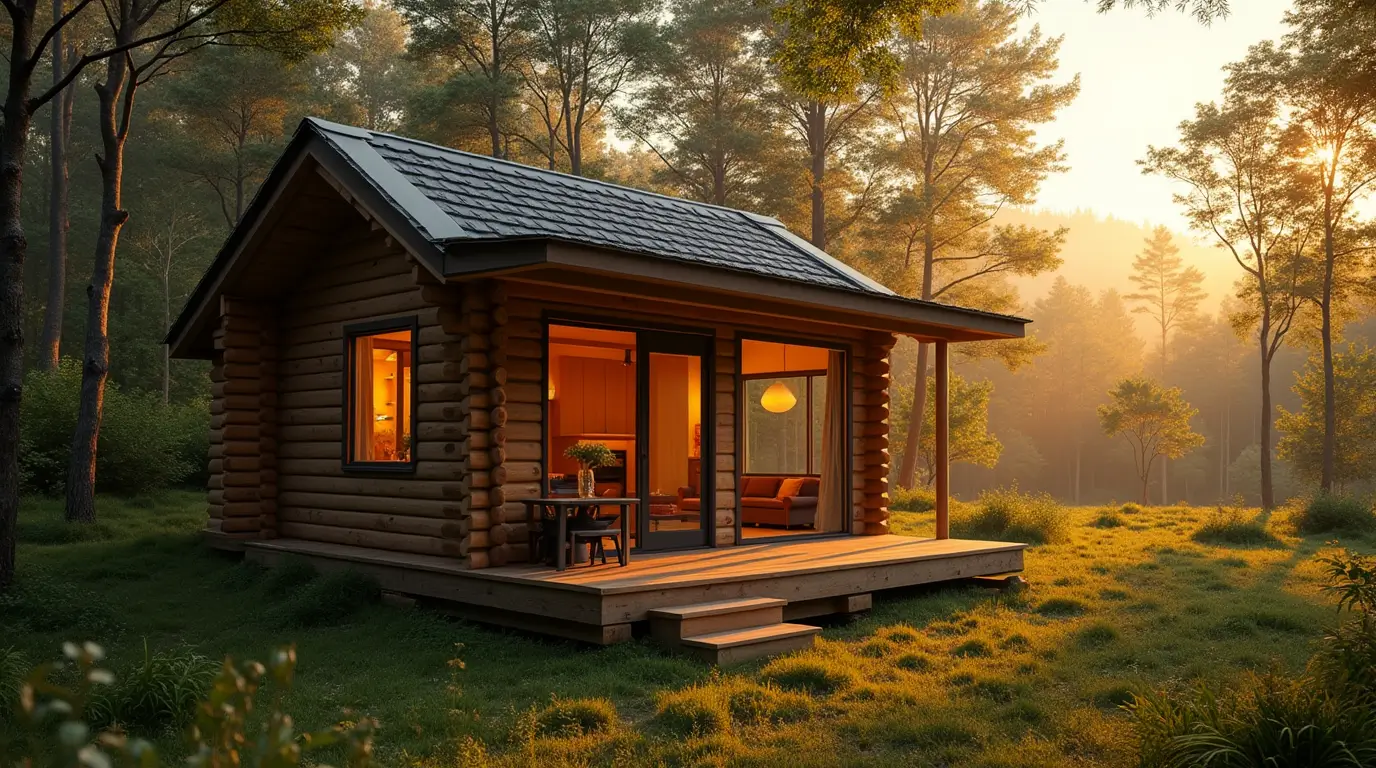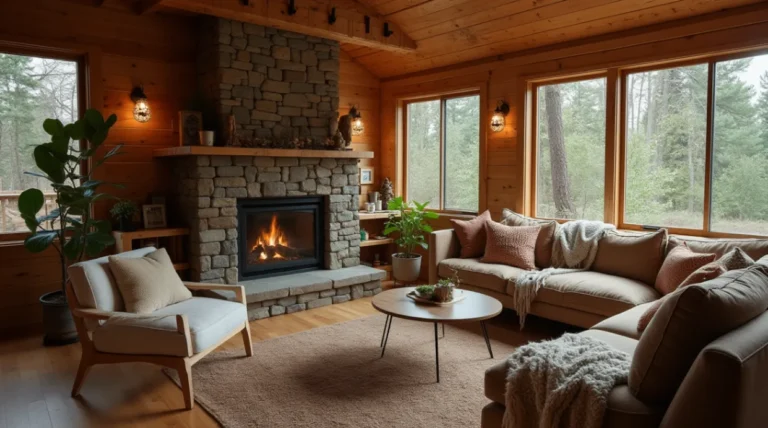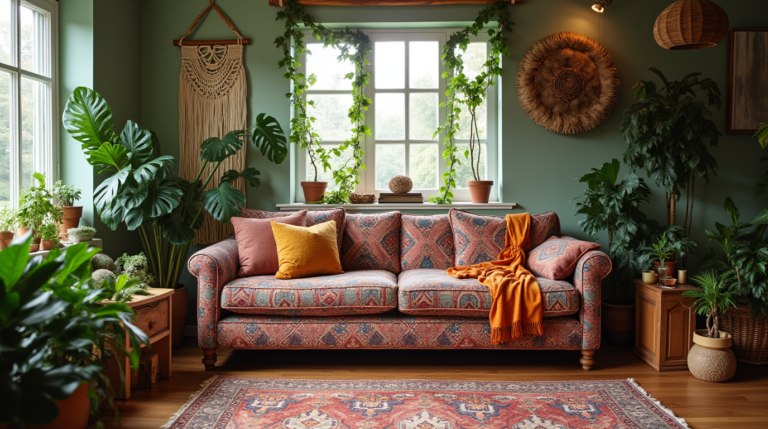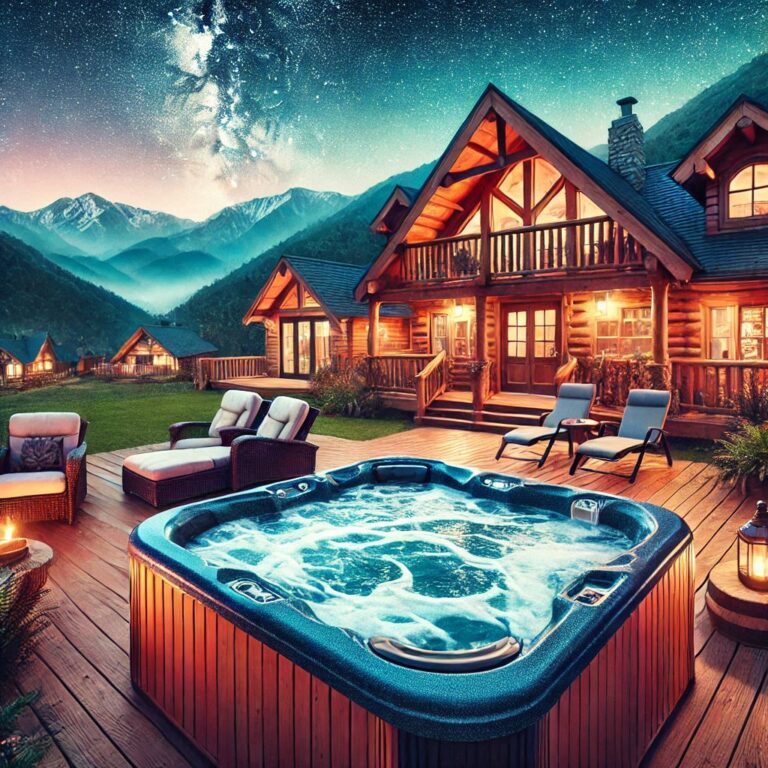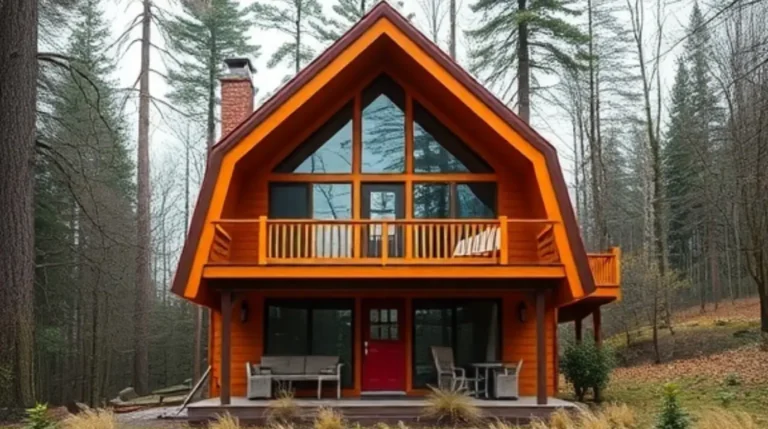Tiny Cabin Ideas That Make a Big Impact
Many dream of escaping to a cozy retreat in the woods. Living in a tiny cabin might seem small, but it can be incredibly comfortable and stylish with the right design.

The charm of tiny cabin living is its simplicity and connection to nature. As more people embrace this trend, they seek ways to make the most of their space without losing beauty.
This article will dive into smart solutions and design tricks for tiny cabin living. It shows how these small spaces can become peaceful retreats.
Key Takeaways
- Maximizing space in a tiny cabin requires creative design solutions.
- Incorporating natural elements can enhance the cozy atmosphere.
- Smart storage is crucial for maintaining a clutter-free environment.
- Multifunctional furniture is key to optimizing space.
- A well-designed tiny cabin can be both stylish and functional.
The Growing Appeal of Tiny Cabin Living
As housing costs rise and environmental issues grow, tiny cabins are becoming a popular choice. They offer a simpler, greener way to live that’s also affordable. This lifestyle is both good for your wallet and the planet.
Tiny cabins make you think differently about stuff and space. It’s not just about less clutter. It’s about living more efficiently and simply.
Why Tiny Cabins Are Gaining Popularity
Several reasons explain why tiny cabins are becoming more popular. They’re a budget-friendly housing option in a pricey market. They also encourage a closer connection with nature, making for a more sustainable lifestyle.
Living in a tiny cabin also means more freedom and adventure. With no big mortgage or upkeep worries, you can travel, explore hobbies, or just enjoy your cozy home.
| Benefits | Description |
|---|---|
| Affordability | Tiny cabins are generally cheaper than traditional houses, making homeownership more accessible. |
| Sustainability | Smaller spaces require less energy to heat and cool, reducing the carbon footprint. |
| Simplified Living | Living in a small space encourages minimalism and reduces clutter. |
Key Benefits of Downsizing to a Compact Dwelling
Downsizing to a tiny cabin offers many perks, like saving money and being kinder to the environment. One big plus is the lower costs for housing, utilities, and upkeep.
Also, living small means a cleaner, more organized life. With less space, you focus on what’s truly important or useful.

Overcoming Common Tiny Living Challenges
While tiny cabin living is rewarding, it comes with its own set of challenges. These include finding space for everything and planning your space wisely. Creative storage and multi-use furniture can help solve these issues.
It’s also important to consider the mental side of living small. It’s about valuing experiences and people over things. With this mindset, the benefits of tiny cabin living can be much greater than the challenges.
How to Plan Your Perfect Tiny Cabin Layout
Creating an efficient layout is key for tiny cabin living. Every square foot matters. A well-designed layout makes the space more functional and comfortable.
Assessing Your Essential Space Requirements
Before designing your tiny cabin, think about your space needs. List your daily activities and the space needed for each. Consider the number of people and privacy needs. Think about your lifestyle and what you need to feel comfortable. This will help you figure out the minimum space needed.
Creating Distinct Functional Zones
Divide your tiny cabin into different zones for sleeping, cooking, and relaxing. Use furniture and decor to define these zones without walls. For example, a loft bed can be a sleeping area and storage space underneath.

Designing for Optimal Traffic Flow
A good traffic flow is crucial in a tiny cabin. Make sure there’s a clear path through the cabin. Use the ‘work triangle’ concept for your kitchen, placing sink, stove, and fridge in a triangle for efficiency.
Maximizing Natural Light and Views
Natural light makes a tiny cabin feel bigger and more welcoming. Place windows and skylights to get the most light. Also, arrange furniture to enjoy scenic views.
By assessing your needs, creating zones, ensuring good traffic flow, and maximizing light and views, you can design a tiny cabin that’s both practical and enjoyable. This thoughtful design will give you a minimalist home full of character and function.
Space-Saving Furniture Solutions for Tiny Cabins
Tiny cabins need careful furniture choices to be cozy and functional. The right furniture makes a big difference in how roomy and comfy a tiny cabin feels.
Selecting Multi-Functional Furniture Pieces
Choosing furniture that does more than one thing is key for saving space in tiny cabins. Multi-functional furniture cuts down on clutter and makes the space more useful.
Convertible Sofas and Murphy Beds
Convertible sofas and Murphy beds are perfect for tiny cabins. They offer a comfy spot to sit or sleep that can be folded up when not needed. This frees up floor space.
Expandable Tables and Nesting Furniture
Expandable tables and nesting furniture are also great for tiny cabins. They can grow or change shape as needed. This gives flexibility and usefulness without taking up too much space.
| Furniture Type | Benefits | Examples |
|---|---|---|
| Multi-Functional | Saves space, reduces clutter | Convertible sofas, Murphy beds |
| Expandable/Nesting | Flexible, adaptable | Expandable tables, nesting chairs |
| Built-In | Space-efficient, customized | Built-in shelves, banquettes |
Incorporating Built-In Furniture
Built-in furniture is a smart way to use space in tiny cabins. It fits seamlessly into the cabin’s design, making the most of every inch.

Utilizing Foldable and Collapsible Designs
Foldable and collapsible furniture adds flexibility to tiny cabin living. These pieces can be tucked away when not needed. This keeps the space tidy and open.
With these space-saving furniture ideas, you can make a tiny cabin feel big and cozy. It’s the perfect spot for a cozy retreat.
Innovative Storage Ideas for Your Tiny Cabin
Effective storage is key in a tiny cabin. Every inch matters, and smart storage can greatly improve your home’s feel and function.
Implementing Vertical Storage Solutions
Using vertical space is a smart move. Shelves, storage units, or hooks on the ceiling can boost storage without taking up floor space.
- Use wall-mounted shelves for books, decorative items, or kitchenware.
- Install hanging organizers for jackets, bags, or accessories.
- Invest in stackable storage bins or baskets for storing items like linens or out-of-season clothing.
Creating Hidden Storage Opportunities
Hidden storage keeps your cabin tidy and organized. By hiding storage in furniture or decor, you can keep things neat while maintaining a minimalist look.
Some ideas include:
- Using storage ottomans or coffee tables with built-in storage.
- Incorporating hidden compartments into your furniture, such as a bed frame with drawers.
- Utilizing under-bed storage for items like linens, out-of-season clothing, or luggage.

Installing Dual-Purpose Storage Furniture
Dual-purpose furniture is a big help in small spaces. It reduces clutter and boosts your cabin’s functionality.
| Furniture Piece | Primary Function | Secondary Storage Function |
|---|---|---|
| Storage Ottoman | Seating | Storing linens, toys, or accessories |
| Murphy Bed | Sleeping | Creating floor space when not in use |
| Coffee Table with Storage | Surface for drinks and snacks | Storing books, magazines, or remote controls |
Developing Organizational Systems for Small Spaces
An organizational system is vital for a clutter-free cabin. It helps keep your belongings organized and easy to find, making your home tidy and stress-free.
Consider these tips:
- Categorize your belongings into groups (e.g., cleaning supplies, kitchen utensils).
- Assign a designated storage space for each group.
- Use labels or signs to identify what’s stored in each area.
Tiny Cabin Interior Design Strategies That Create Spaciousness
Tiny cabins can feel surprisingly spacious with the right design. The challenge is to make the most of a small space. With a few key design principles, you can turn your tiny cabin into a cozy retreat that feels big and welcoming.

Choosing Color Schemes That Expand Visual Space
The color scheme greatly affects how big your tiny cabin feels. Lighter colors on walls and ceilings make the space feel open. Try soft whites, pale grays, and muted blues for a calming and expansive feel.
| Color Scheme | Effect on Space | Recommended Shades |
|---|---|---|
| Monochromatic | Creates a sense of continuity | Various shades of white or gray |
| Light Neutrals | Makes the space feel larger | Soft whites, creams, pale grays |
| Cool Pastels | Adds a calming effect | Mint green, pale blue, lavender |
Positioning Mirrors and Lighting for Maximum Effect
Mirrors and lighting are key to making your cabin feel bigger. Place mirrors opposite windows to reflect light and views. Layered lighting (ambient, task, and accent) also helps by eliminating dark spots and making the space feel open.
Selecting Textures and Materials That Work in Small Spaces
The textures and materials you choose matter a lot. Mix smooth surfaces, natural woods, and soft fabrics for depth without clutter. Choose items that serve more than one purpose, like a wooden storage ottoman, for both function and style.
Applying Minimalist Decorating Principles
Minimalist decorating is essential for a spacious feel. Focus on a few statement pieces and keep surfaces clear. This creates a clean, uncluttered space that feels bigger.
By using these design strategies, you can make your tiny cabin feel spacious, inviting, and just right for you.
How to Extend Your Living Space Outdoors
Creating an inviting outdoor space is a great way to expand your tiny cabin. It lets you increase your living area without big costs. This makes your compact dwelling more functional and enjoyable.
Designing Functional Outdoor Extensions
When designing outdoor extensions, think about their purpose. Will it be for dining, relaxing, or entertaining? Knowing this helps you design it right, making sure it meets your needs. For example, a durable outdoor table and comfy seating are good for dining.
Building Space-Efficient Decks and Patios
Building a deck or patio is a smart way to expand outdoors. Use multi-level decks or compact patio designs to save space. Choose durable materials like composite decking or porcelain pavers for easy upkeep in small spaces.
| Material | Durability | Maintenance |
|---|---|---|
| Composite Decking | High | Low |
| Porcelain Pavers | High | Low |
| Natural Wood | Medium | Medium |
Creating Seamless Indoor-Outdoor Transitions
To blend indoors and outdoors, use large sliding glass doors or folding glass walls. These features offer clear views and easy movement between spaces. They make the two areas feel like one.
Using the same flooring indoors and outdoors also helps with continuity.
Adapting Outdoor Spaces for All Seasons
To enjoy your outdoor space all year, adapt it for different seasons. Add outdoor heaters, fire pits, or shade structures as needed. For example, heaters can keep your space cozy in winter.
Smart Technology Integration for Tiny Cabin Living
Smart technology is changing how we live in tiny cabins. It makes living more comfortable, efficient, and fun.
Smart tech includes space-saving appliances. These appliances are small and use less energy. For example, induction cooktops and compact refrigerators save energy and work well in tiny spaces.
Installing Space-Efficient Appliances
Choosing the right appliances for a tiny cabin is key. Look for ones that are small and use less energy. Here are some good options:
- Compact dishwashers save water and space
- Microwave ovens do many cooking tasks in one
- Energy-saving refrigerators use less power
As
“The future of tiny living is not just about downsizing, but about upgrading our lives with smart technology.”
This quote shows why technology is important in tiny cabins.
Setting Up Home Automation Systems
Home automation makes tiny cabins better. It lets you control lights, temperature, and security easily. For instance, smart thermostats learn your preferences to save energy.
Home automation offers many benefits:
- It saves energy by adjusting heating and cooling
- It boosts security with smart locks and cameras
- It makes life easier with voice-controlled lights and entertainment
Implementing Energy-Efficient Solutions
Being energy-efficient is vital in tiny cabins. Solutions like solar panels, rainwater harvesting, and insulation help. They cut down on waste and save resources.
| Energy-Efficient Solution | Benefits |
|---|---|
| Solar Panels | Use renewable energy, lower bills |
| Rainwater Harvesting | Saves water, cuts water bills |
| Energy-Efficient Insulation | Keeps heat in, uses less energy |
Configuring Compact Entertainment Systems
Entertainment is key in any home, including tiny cabins. Compact systems like soundbars and streaming devices offer great fun without taking up much space.
Smart tech makes tiny cabin living better. As tech gets better, we’ll see more cool solutions for tiny homes.
Sustainable Features to Incorporate in Your Tiny Cabin
Tiny cabins are great for living green. They let you use eco-friendly features. This way, you can lower your impact on the planet and enjoy your home more.
Eco-Friendly Building Materials
Choosing the right materials is key for a green tiny cabin. Eco-friendly materials cut down on harm to the environment. They also make your air cleaner. Here are some good choices:
- Reclaimed wood
- Bamboo
- Recycled metal
- Low-VOC paints
A study by the National Association of Home Builders shows green materials can boost your home’s value by up to 10%.
Off-Grid Systems
Off-grid systems make your tiny cabin more eco-friendly. They help you use less public utilities and be more self-sufficient.
| System | Description | Benefits |
|---|---|---|
| Solar Power | Generates electricity from sunlight | Renewable energy source, reduces electricity bills |
| Rainwater Harvesting | Collects and stores rainwater for use | Conserves water, reduces water bills |
| Composting Toilets | Converts waste into compost | Reduces water usage, produces nutrient-rich compost |
The U.S. Department of Energy says off-grid systems offer energy freedom and lower environmental harm.
“The best way to get started is to quit talking and begin doing.”
— Walt Disney
Water Conservation Strategies
Water-saving steps are essential for a green tiny cabin. Simple actions can cut down water use a lot.
- Install low-flow fixtures
- Use a rainwater harvesting system
- Implement greywater reuse systems
Minimal Waste Generation
Creating less waste is crucial for a sustainable tiny cabin. By living simply and using less, you can lessen your environmental impact.
Here are some ways to do it:
- Reduce packaging waste
- Compost organic waste
- Recycle materials
Real-Life Tiny Cabin Transformations: Before and After
Tiny cabins are turning into stunning homes in mountains and deserts. They show the potential of small spaces and the creativity in designing them.
These examples show how tiny cabins can be made into luxurious homes. They fit different environments and needs, proving they can be both beautiful and functional.
Mountain Retreat: 200 Square Feet of Luxury
A tiny cabin in the mountains can be a peaceful retreat. It offers amazing views and a cozy feel. This 200-square-foot cabin is a great example of luxury in a small space.
| Feature | Description | Benefit |
|---|---|---|
| Loft Bed | Elevated sleeping area | Maximizes floor space |
| Multi-functional Furniture | Furniture that serves more than one purpose | Reduces clutter and enhances functionality |
| Large Windows | Floor-to-ceiling windows | Provides panoramic views and natural light |
Lakeside Tiny Cabin: Maximizing Water Views
A lakeside tiny cabin connects you with nature. It uses big windows and outdoor spaces to make the most of the water views. This creates a smooth transition between inside and outside.
Forest Hideaway: Blending with Nature
Tiny cabins in forests can blend right in. They use natural materials and colors to match the environment. This forest hideaway shows how to live in harmony with nature.
Desert Oasis: Climate-Adapted Tiny Living
Building a tiny cabin in the desert needs special care. It must be well-insulated and shaded. This desert oasis shows how to make a cozy home in the desert. It uses solar panels and collects rainwater.
Conclusion: Embracing the Big Impact of Your Tiny Cabin
A well-designed tiny cabin can be a minimalist home that feels luxurious, comfortable, and green. By using smart strategies and design, you can make a cozy retreat. It will meet and even exceed your needs.
The secret to a great tiny cabin is using space wisely. It should feel like a natural extension of the outdoors. Adding smart tech can make your living space even better.
As shown in the examples, tiny cabins can become perfect escapes. They’re great for downsizing or trying something new. With good planning and focus on details, you can build a minimalist home that’s both useful and beautiful. It will be a true cozy retreat.
FAQ
What are the benefits of living in a tiny cabin?
A tiny cabin lifestyle can save you money and reduce your environmental impact. It encourages a simpler way of living. Plus, it sparks creativity in design and organization.
How can I maximize space in my tiny cabin?
To make the most of your space, use furniture that serves more than one purpose. Plan your layout for easy movement. Use vertical storage and choose colors and materials that make the space feel bigger.
What are some innovative storage ideas for tiny cabins?
Try vertical storage and hidden spots for your belongings. Use furniture that has storage built-in. Keeping things organized with labels and categories helps keep your space tidy.
How can I make my tiny cabin feel more spacious?
Use light colors and mirrors to make your cabin feel larger. Position lighting and furniture to create a sense of openness. Minimalist decor also helps to keep the space feeling airy.
Can I extend my living space outdoors in a tiny cabin?
Yes, you can. Design outdoor areas that are functional and efficient. Build decks and patios that fit well with your cabin. Make your outdoor spaces work for all seasons.
What smart technology can I integrate into my tiny cabin?
Integrate smart tech like space-saving appliances and home automation. Use energy-efficient solutions and compact entertainment systems. These upgrades can make your cabin more comfortable and efficient.
How can I make my tiny cabin more sustainable?
To make your cabin eco-friendly, choose sustainable materials and set up off-grid systems. Implement water-saving strategies and design for minimal waste. These steps can reduce your environmental impact.
What are some key considerations when planning a tiny cabin layout?
First, figure out what space you really need. Create zones for different activities. Plan for easy movement and make the most of natural light. Good planning ensures a cozy and functional cabin.
How can I incorporate cozy elements into my tiny cabin?
To make your cabin cozy, use soft textiles and warm lighting. Choose inviting colors. A cozy cabin balances simplicity with thoughtful touches.
What are some popular design styles for tiny cabins?
Popular styles include minimalist, rustic, and modern. Your choice depends on your surroundings, personal taste, and the mood you want to create.

